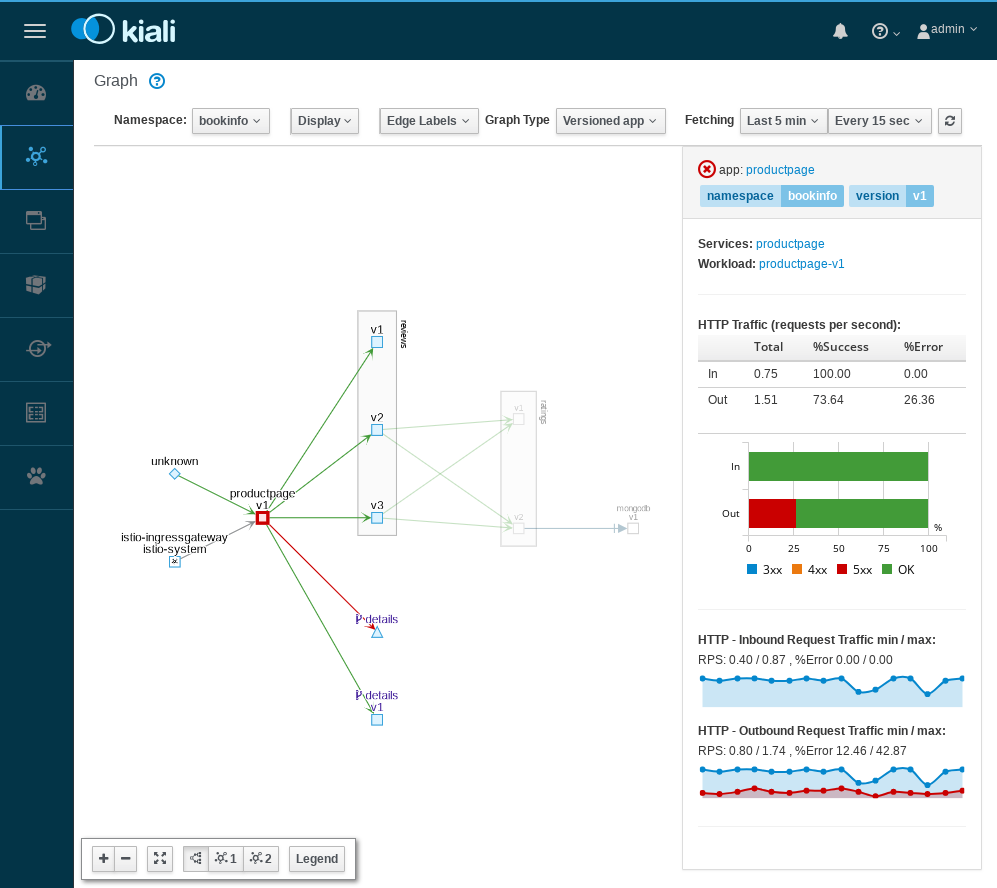Workshop: Using Istio
Lee Calcote and Abishek Kumar, Layer5


cloud native and its management




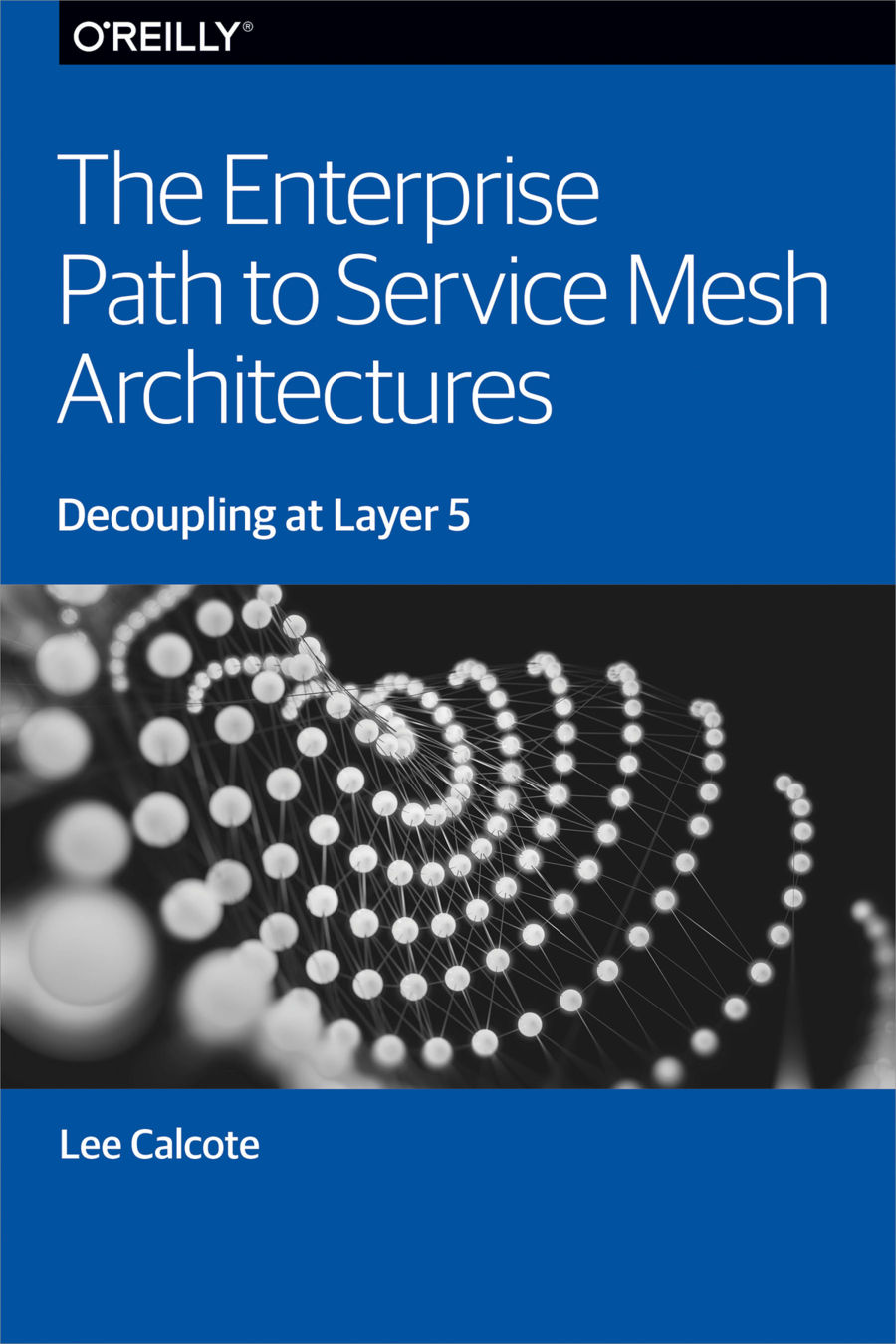
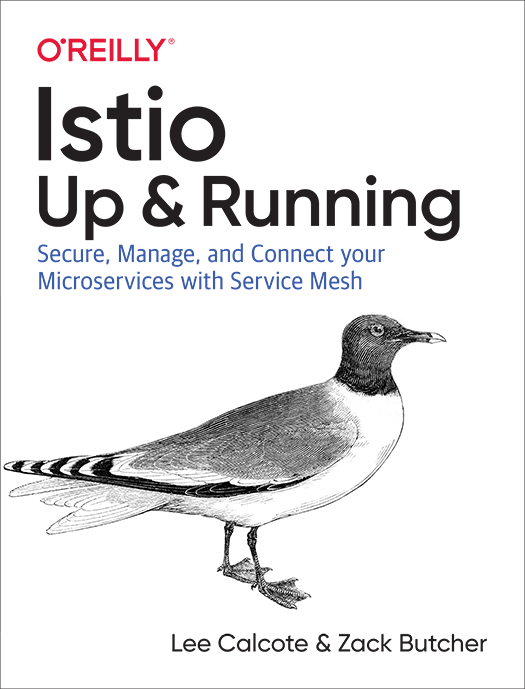
Service Mesh Patterns

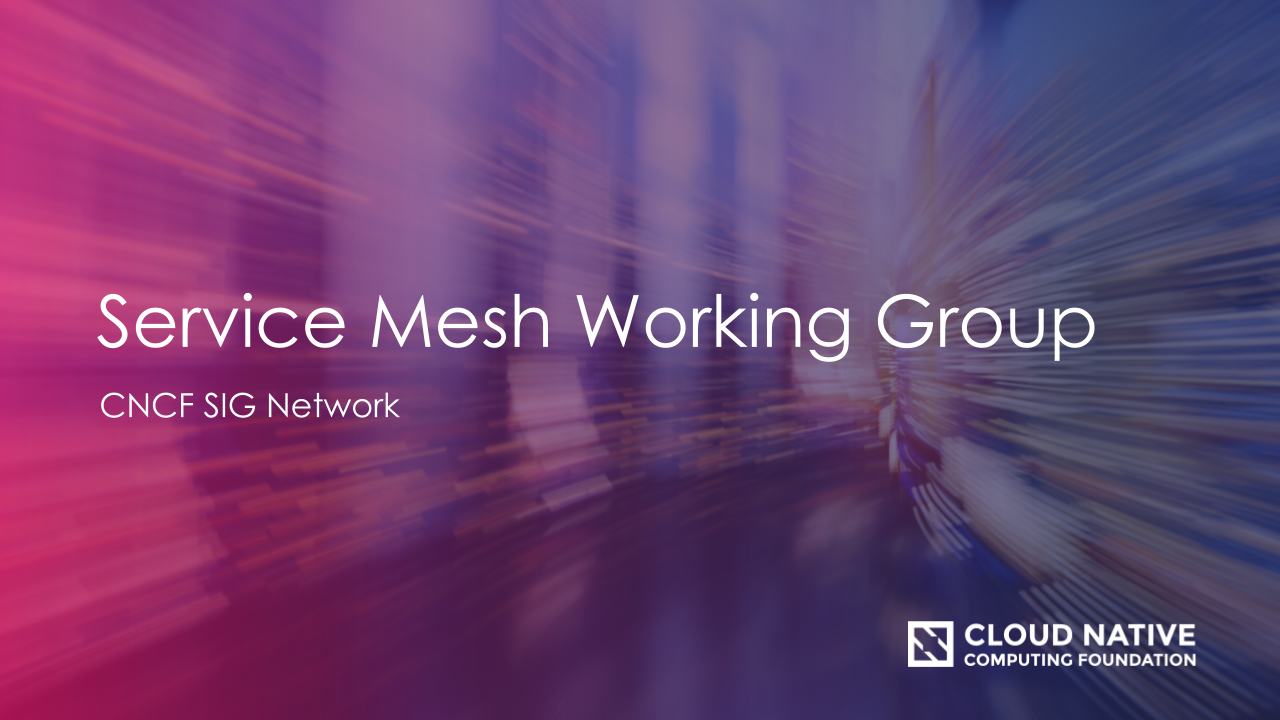
Abishek Kumar
@abd_abishek

Utkarsh Srivastava
@utkarsh-pro

Connect
Collaborate
Contribute

Join the Community

Confirm Prerequisites
-
Start Docker Desktop, Minikube or other.
(either single-node or multi-node clusters will work) -
Verify that you have a functional Docker environment by running :
$ docker run hello-world
Unable to find image 'hello-world:latest' locally
latest: Pulling from library/hello-world
1b930d010525: Pull complete
Digest: sha256:0e11c388b664df8a27a901dce21eb89f11d8292f7fca1b3e3c4321bf7897bffe
Status: Downloaded newer image for hello-world:latest
Hello from Docker!Docker and Kubernetes

Prereq

Prepare Docker Desktop
Ensure your Docker Desktop VM has 4GB of memory assigned.
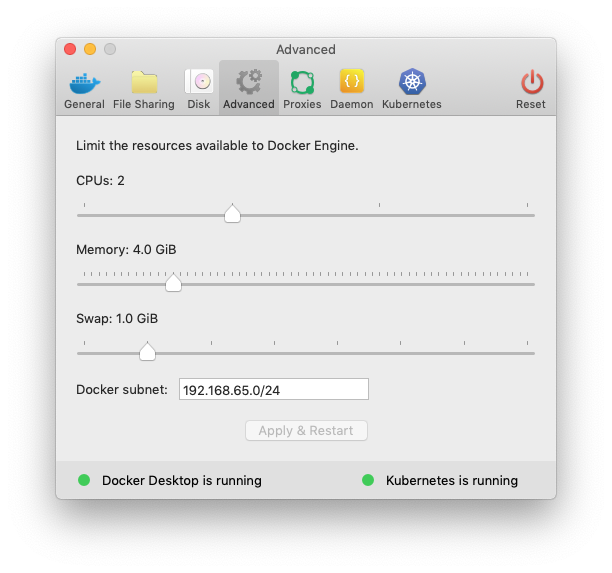
Ensure Kubernetes is enabled.
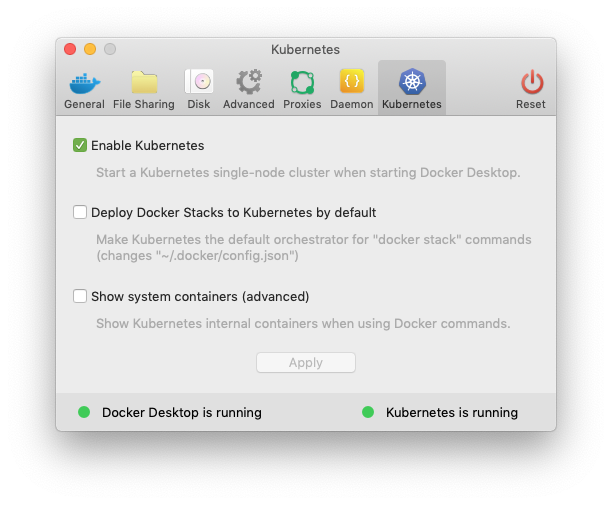

Prereq

Deploy Kubernetes
- Confirm access to your Kubernetes cluster.
$ kubectl version --short
Client Version: v1.19.2
Server Version: v1.18.8$ kubectl get nodes
NAME STATUS ROLES AGE VERSION
docker-desktop Ready master 10m v1.18.8
Prereq
v1.9 or higher

What is a Service Mesh?
a services-first network
layer5.io/books/the-enterprise-path-to-service-mesh-architectures
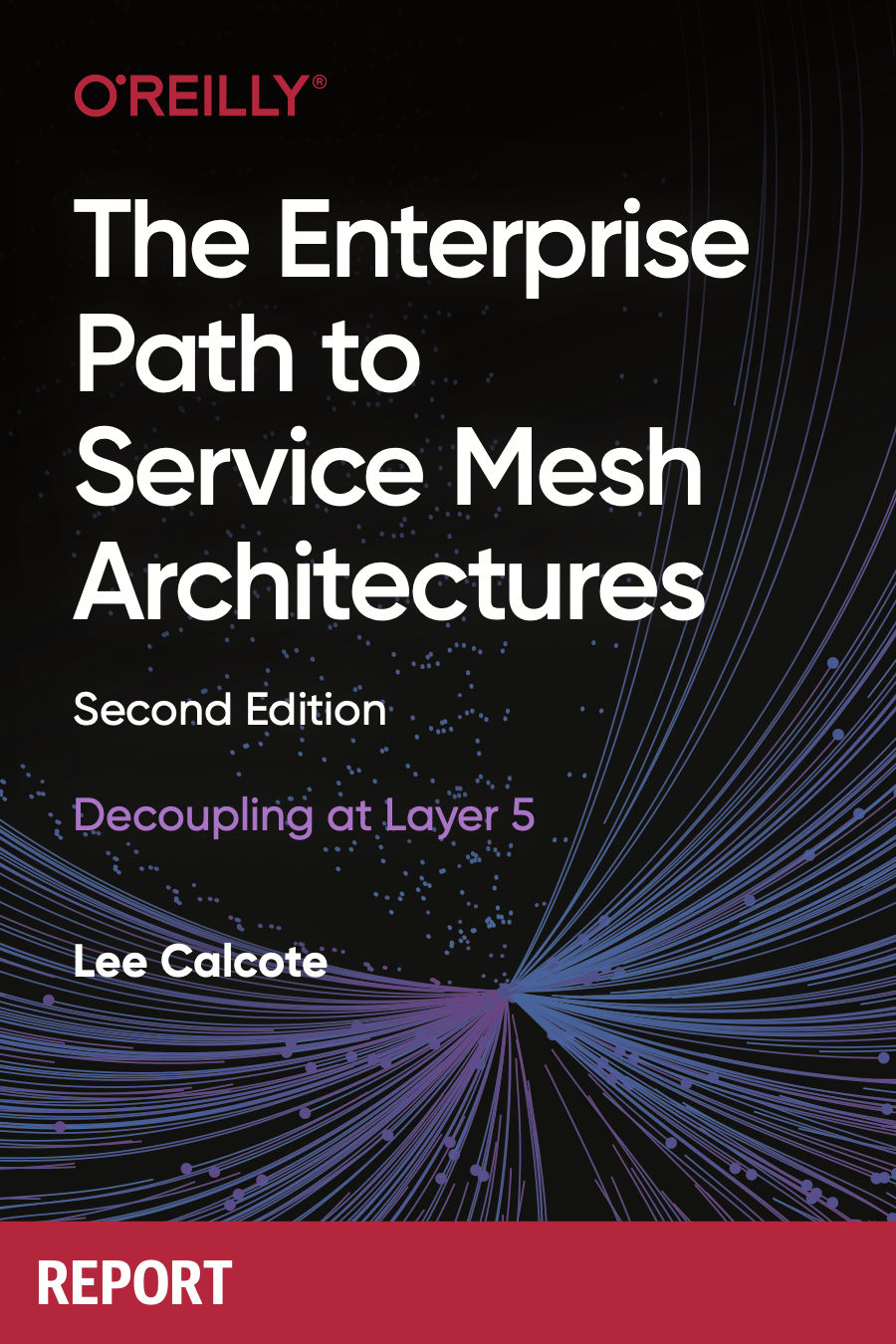

Traffic Control
control over chaos
Resilency
content-based traffic steering
Observability
what gets people hooked on service metrics
Security
identity and policy
Service Mesh Functionality
Expect more from your infrastructure
Business Logic
in-network application logic

What is Istio?
an open platform to connect, manage, and secure microservices
-
Observability
-
Resiliency
-
Traffic Control
-
Security
-
Policy Enforcement


@IstioMesh

Observability
what gets people hooked on service metrics
Goals
-
Metrics without instrumenting apps
-
Consistent metrics across fleet
-
Trace flow of requests across services
-
Portable across metric back-end providers
You get a metric! You get a metric! Everyone gets a metric!
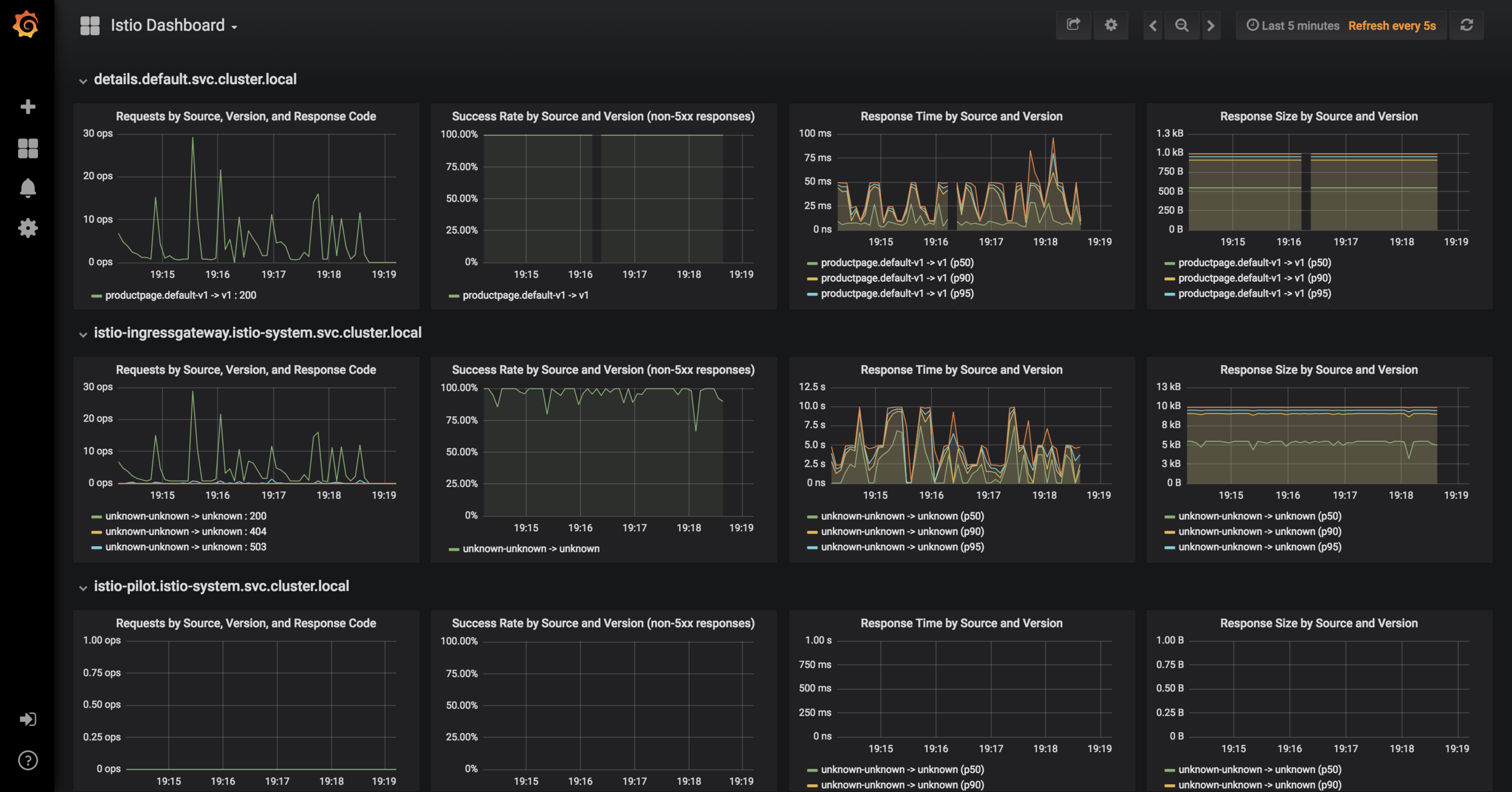

Traffic Control
control over chaos
- Traffic splitting
- L7 tag based routing?
- Traffic steering
- Look at the contents of a request and route it to a specific set of instances.
- Ingress and egress routing
Resilency
- Systematic fault injection
-
Timeouts and Retries with timeout budget
-
Control connection pool size and request load
-
Circuit breakers and Health checks
content-based traffic steering
Missing: application lifecycle management, but not by much
Missing: distributed debugging; provide nascent visibility (topology)

DEVELOPER
OPERATOR
Decoupling at Layer 5
where Dev, Ops, Product meet
Empowered and independent teams can iterate faster
PRODUCT OWNER

DEVELOPER
OPERATOR
Decoupling at Layer 5
where Dev, Ops, Product meet
Empowered and independent teams can iterate faster
PRODUCT OWNER

Relating to
Service Meshes
Which is why...
I have a container orchestrator.


Core
Capabilities
-
Cluster Management
-
Host Discovery
-
Host Health Monitoring
-
-
Scheduling
-
Orchestrator Updates and Host Maintenance
-
Service Discovery
-
Networking and Load Balancing
-
Stateful Services
-
Multi-Tenant, Multi-Region
Additional
Key Capabilities
-
Application Health and Performance Monitoring
-
Application Deployments
-
Application Secrets

minimal capabilities required to qualify as a container orchestrator
Service meshes generally rely on these underlying layers.

Which is why...
I have an API gateway.
Microservices API Gateways
-
Ambassador uses Envoy
-
Kong uses Nginx
-
OpenResty uses Nginx
north-south vs. east-west



Which is why...
I have client-side libraries.
Enforcing consistency is challenging.
Foo Container
Flow Control
Foo Pod
Go Library
A v1
Network Stack
Service Discovery
Circuit Breaking
Application / Business Logic
Bar Container
Flow Control
Bar Pod
Go Library
A v2
Network Stack
Service Discovery
Circuit Breaking
Application / Business Logic
Baz Container
Flow Control
Baz Pod
Java Library
B v1
Network Stack
Service Discovery
Circuit Breaking
Application / Business Logic
Retry Budgets
Rate Limiting

Help with Modernization
-
Can modernize your IT inventory without:
-
Rewriting your applications
-
Adopting microservices, regular services are fine
-
Adopting new frameworks
-
Moving to the cloud
-
address the long-tail of IT services
Get there for free


Why use a Service Mesh?
-
Bloated service (application) code
-
Duplicating work to make services production-ready
-
Load balancing, auto scaling, rate limiting, traffic routing...
-
-
Inconsistency across services
-
Retry, tls, failover, deadlines, cancellation, etc., for each language, framework
-
Siloed implementations lead to fragmented, non-uniform policy application and difficult debugging
-
-
Diffusing responsibility of service management


to avoid...

Q&A
Service Mesh Architectures

Service Mesh Architectures
Data Plane
-
Touches every packet/request in the system.
-
Responsible for service discovery, health checking, routing, load balancing, authentication, authorization, and observability.
Ingress Gateway
Egress Gateway

Service Mesh Architecture
No control plane? Not a service mesh.
Control Plane
-
Provides policy, configuration, and platform integration.
-
Takes a set of isolated stateless sidecar proxies and turns them into a service mesh.
-
Does not touch any packets/requests in the data path.
Data Plane
-
Touches every packet/request in the system.
-
Responsible for service discovery, health checking, routing, load balancing, authentication, authorization, and observability.
Ingress Gateway
Egress Gateway

Service Mesh Architecture
Control Plane
Data Plane
-
Touches every packet/request in the system.
-
Responsible for service discovery, health checking, routing, load balancing, authentication, authorization, and observability.
-
Provides policy, configuration, and platform integration.
-
Takes a set of isolated stateless sidecar proxies and turns them into a service mesh.
-
Does not touch any packets/requests in the data path.
You need a management plane.
Ingress Gateway
Management
Plane
-
Provides backend system integration, expanded policy and governance, continuous delivery integration, workflow, chaos engineering, configuration and performance management and multi-mesh federation.
Egress Gateway

Service Mesh Architecture
Pilot
Citadel
Mixer
Control Plane
Data Plane
istio-system namespace
policy check
Foo Pod
Proxy Sidecar
Service Foo
tls certs
discovery & config
Foo Container
Bar Pod
Proxy Sidecar
Service Bar
Bar Container
Out-of-band telemetry propagation
telemetry
reports
Control flow
application traffic
Application traffic
application namespace
telemetry reports
Istio Architecture

Galley
Ingress Gateway
Egress Gateway

Control Plane
Data Plane
octa-system namespace
policy check
Foo Pod
Proxy
Sidecar
Service Foo
discovery & config
Foo Container
Bar Pod
Service Bar
Bar Container
Out-of-band telemetry propagation
telemetry
reports
Control flow
application traffic
Application traffic
application namespace
telemetry reports

Policy
Engine
Security Engine
Visibility
Engine

+
Proxy
Sidecar

+
Octarine Architecture

Control Plane
Data Plane
linkerd namespace
Foo Pod
Proxy Sidecar
Service Foo
Foo Container
Bar Pod
Proxy Sidecar
Service Bar
Bar Container
Out-of-band telemetry propagation
telemetry
scarping
Control flow during request processing
application traffic
Application traffic
application namespace
telemetry scraping
Architecture
Prometheus
Grafana
web
CLI
public-api
Linkerd


linkerd-controller
sp-validator
Control Plane
destination
tap
web
CLI
proxy-injector
identity

Leader
Agent
Control Plane
Data Plane
intentions
Foo Pod
Proxy Sidecar
Service Foo
discovery, config,
tls certs
Foo Container
Bar Pod
Proxy Sidecar
Service Bar
Bar Container
Control flow
application traffic
Application traffic
application namespace
Follower
Consul Client
Consul Servers
Follower
policy
check
Consul Architecture

layer5.io/service-mesh-architectures
WASM Filter
node

Our service mesh of study: Istio
What are Galley and Pilot?
provides service discovery to sidecars
manages sidecar configuration
Pilot
Citadel
the head of the ship
Ingress
istio-system namespace
system of record for service mesh



}
provides abstraction from underlying platforms
Galley
Control Plane

What's Mixer for?
- Point of integration with infrastructure back ends
- Intermediates between Istio and back ends, under operator control
- Enables platform and environment mobility
- Responsible for policy evaluation and telemetry reporting
- Provides granular control over operational policies and telemetry
- Has a rich configuration model
- Intent-based config abstracts most infrastructure concerns
an attribute-processing and routing machine
operator-focused
- Precondition checking
- Quota management
- Telemetry reporting
Pilot
Citadel
Telemetry Filter
istio-system namespace
Galley
Control Plane
Ingress
Data Plane

Mixer-less
Control Plane
Data Plane
istio-system namespace
Foo Pod
Proxy sidecar
Service Foo
Foo Container
Out-of-band telemetry propagation
Control flow during request processing
application traffic
application traffic
application namespace
telemetry reports
an attribute processing engine

What's Citadel for?
-
Verifiable identity
- Issues certs
- Certs distributed to service proxies
- Mounted as a Kubernetes secret
- Secure naming / addressing
- Traffic encryption
security at scale
security by default
Orchestrate Key & Certificate:
- Generation
- Deployment
- Rotation
- Revocation
Pilot
Citadel
Mixer
istio-system namespace
Galley
Control Plane

layer5.io/landscape
It's meshy out there.
Strengths of Service Mesh Implementations
Different tools for different use cases
a sample


Service mesh abstractions
Meshery is interoperable with these abstractions.
Service Mesh Interface
(SMI)
Multi-Vendor Service Mesh Interoperation (Hamlet)
Service Mesh Performance (SMP)
A standard interface for service meshes on Kubernetes.
A set of API standards for enabling service mesh federation.
A format for describing and capturing service mesh performance.
to the rescue




Service Mesh Interface (SMI) Conformance
Operate and upgrade with confirmation of SMI compatibility
✔︎ Learn Layer5 sample application used for validating test assertions.
✔︎ Defines compliant behavior.
✔︎ Produces compatibility matrix.
✔︎ Ensures provenance of results.
✔︎ Runs a set of conformance tests.
✔︎ Built into participating service mesh’s release pipeline.
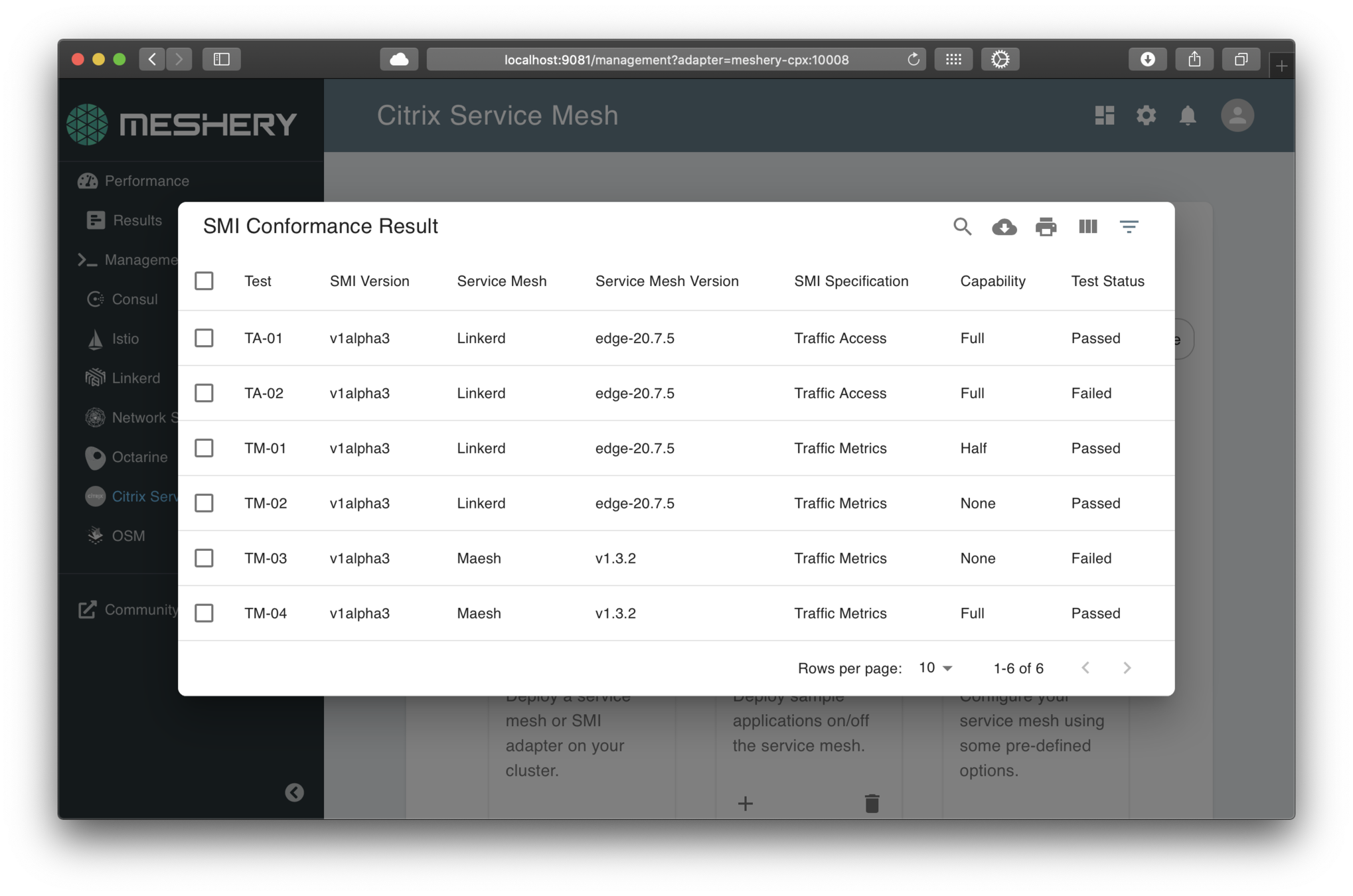




Service Mesh Patterns by the Book
Service Mesh Patterns


| Service Communication | Low inter-service communication. | High inter-service communication. |
|---|---|---|
| Observability | Edge focus—metrics and usage are for response time to clients and request failure rates. | Uniform and ubiquitious—observability is key for understanding service behavior. |
| Client Focus | Strong separation of external and internal users. Focused on external API experience. | Equal and undifferentiated experience for internal and external users. |
| World-view of APIs | Primary client-facing interaction is through APIs are for clients only (separation of client-facing or service-to-service communication) | APIs are treated as a product; APIs are how your application exposes its capabilities. |
| Security Model | Security at perimeter | Encryption between all services |
| Security Model... | Subnet zoning (firewalling) | Zero-trust mindset |
| Security Model... | Trusted internal networks (gooey center) | authN and authZ between all services |
| Size of Org | Smaller organizations | Larger organizations |
| # of Services | 1 to 5 services | 5 or more services |
| Service Relability | Either don't need, are willlilng to handcode, or bring in other infrastructure to provide resiliency guarantees. | Need strong controls over the resiliency properties of your services and to granularly control ingress, between, and egress service request traffic. |
| Diversity of Application Stack | Single language | One or more languages |
Lightly consider a service mesh
Strongly consider a service mesh
Consideration
(external client focus)
(internal/external client focus)





Service Mesh Performance (SMP)

meshery.io
Deploy Management Plane
Management
Plane
Provides expanded governance, backend system integration, multi-mesh, federation, expanded policy, and dynamic application and mesh configuration.
Control Plane
Data Plane
brew install layer5io/mesheryctl
mesheryctl system startPrereq
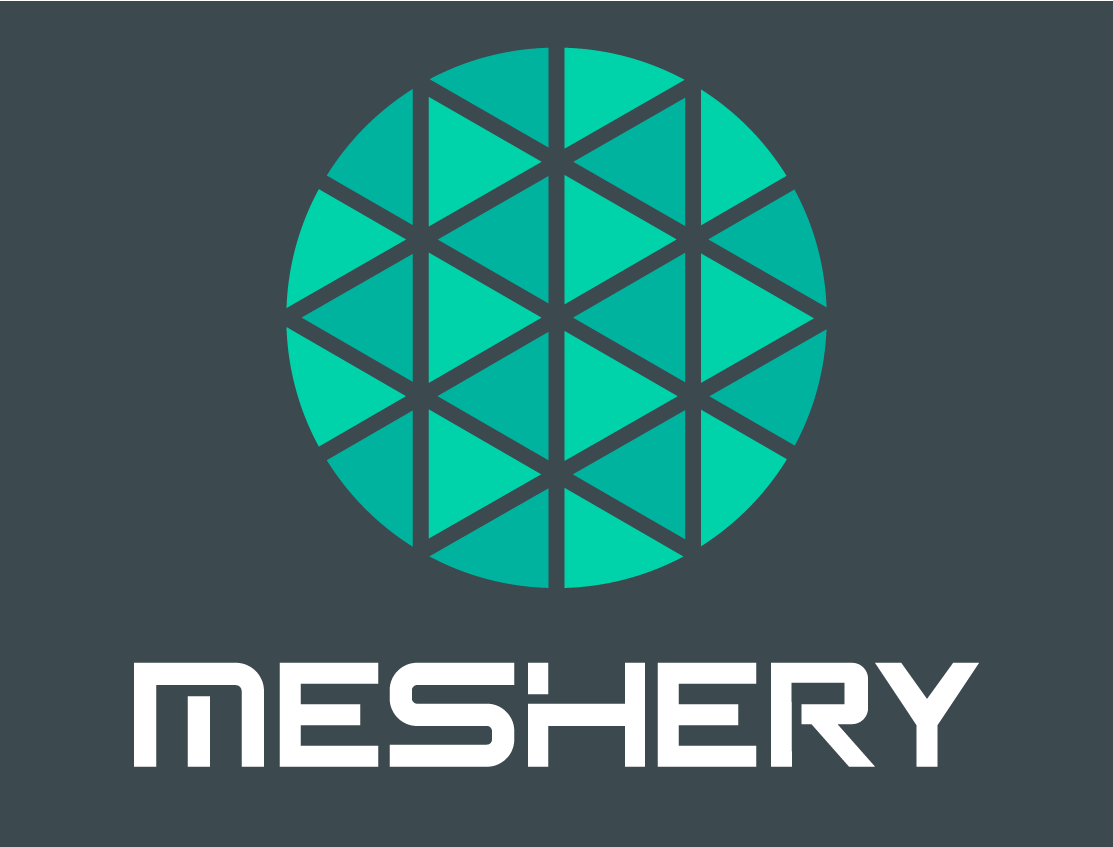
Using brew
Using bash
curl -L https://git.io/meshery | sudo bash - mesheryctl system config minikube --token auth.jsonUsing minikube:




Deploy Istio
- Install Istio using Meshery
- Find control plane namespace
- Inspect control plane services
- Inspect control plane components
open http://localhost:9081kubectl get namespaceskubectl get svc -n istio-systemkubectl get pod -n istio-systemLab 1
github.com/layer5io/advanced-istio-service-mesh-workshop


Q&A

Break
Deploy Sample App
- Multi-language, multi-service application
-
Automatic vs manual sidecar injection
- Verify install
Use Meshery or install manually

Lab 2

Reviews v1
Reviews Pod
Reviews v2
Reviews v3
Product Pod
Details Container
Details Pod
Ratings Container
Ratings Pod

Product Container
Reviews Service
Ratings Service
Details Service
Product Service
BookInfo Sample App

BookInfo Sample App on Service Mesh
Reviews v1
Reviews Pod
Reviews v2
Reviews v3
Product Pod
Details Container
Details Pod
Ratings Container
Ratings Pod

Product Container
Envoy sidecar
Envoy sidecar
Envoy sidecar
Envoy sidecar
Envoy sidecar
Reviews Service
Enovy sidecar
Envoy ingress
Product Service
Ratings Service
Details Service

Sidecar Injection
Automatic sidecar injection leverages Kubernetes' Mutating Webhook Admission Controller.
- Verify whether your Kubernetes deployment supports these APIs by executing:
- Inspect the istio-sidecar-injector webhook:
If your environment does NOT this API, then you may manually inject the istio sidecar.
Lab 2
github.com/layer5io/istio-service-mesh-workshop
kubectl get mutatingwebhookconfigurations
kubectl get mutatingwebhookconfigurations istio-sidecar-injector -o yamlkubectl api-versions | grep admissionregistrationSidecars proxy can be either manually or automatically injected into your pods.

Deploy Sample App with Automatic Sidecar Injection
- Verify presence of the sidecar injector
Envoy ingress
kubectl -n istio-system get deployment -l istio=sidecar-injectorLab 2
github.com/layer5io/istio-service-mesh-workshop
2. Confirm namespace label
kubectl get ns -L istio-injectionExpose BookInfo via Istio Ingress Gateway
- Inspecting the Istio Ingress Gateway
- Configure Istio Ingress Gateway for Bookinfo
- Inspect the Istio proxy of the productpage pod
Istio ingress gateway
application traffic
Lab 3
github.com/layer5io/istio-service-mesh-workshop


Q&A
Telemetry







-
benchmarking of service mesh performance
-
exchange of performance information from system-to-system / mesh-to-mesh
-
apples-to-apples performance comparisons of service mesh deployments.
-
MeshMark - a universal performance index to gauge a service mesh’s efficiency against deployments in other organizations’ environments
Service Mesh Performance
https://smp-spec.io

Directly provides:
Indirectly facilitates:
- a vendor neutral specification for capturing details of infrastructure capacity, service mesh configuration, and workload metadata.
Configuration
Security
Telemetry
Control Plane
Data
Plane
service mesh ns
Foo Pod
Proxy Sidecar
Service Foo
Foo Container
Bar Pod
Proxy Sidecar
Service Bar
Bar Container
Out-of-band telemetry propagation
Control flow
application
traffic
Application traffic
application namespace
Meshery Architecture
Ingress Gateway
Egress Gateway

Management
Plane
meshery
adapters
gRPC
kube-api
kube-system





generated load
http / gRPC traffic
fortio
wrk2
nighthawk
UI
API
workloads
Meshery WASM Filter
CLI



perf analysis
patterns
@mesheryio
Metrics Dashboard
Lab 4
- Expose services with NodePort:
- Find port assigned to Grafana:
kubectl -n istio-system edit svc grafanakubectl -n istio-system get svc grafana

Grafana


Lab 4
Distributed Tracing
Jaeger
github.com/layer5io/advanced-istio-service-mesh-workshop

Distributed Tracing
Jaeger
The istio-proxy collects and propagates the following headers from the incoming request to any outgoing requests:
- x-request-id
- x-b3-traceid
- x-b3-spanid
- x-b3-parentspanid
- x-b3-sampled
- x-b3-flags
- x-ot-span-context
Lab 4
kubectl -n istio-system edit svc tracinggithub.com/layer5io/advanced-istio-service-mesh-workshop

Load Generation

Lab 4
@smp_spec
smp-spec.io
1. Use Meshery to generate load on sample application
2. View in monitoring tools
Lab 4 Tasks


Q&A

Break
Istio Traffic Management Building Blocks
- Virtual services
- Destination rules
- Gateways
- Service and Workload entries
- Sidecars
Lab 5

Request Routing and Canary Testing
- Configure the default route for all services to V1
- Content based routing
- Canary Testing - Traffic Shifting
Lab 5

Fault Injection and Latency
- Inject a route rule to create a fault using HTTP delay
- Inject a route rule to create a fault using HTTP abort
- Verify fault injection

Lab 5

Circuit Breaking
- Deploy a client for the app
- With manual sidecar injection:
- Initial test calls from client to server
- Time to trip the circuit
Lab 5

Timeouts & Retries
Web
Service Foo
Timeout = 600ms
Retries = 3
Timeout = 300ms
Retries = 3
Timeout = 900ms
Retries = 3
Service Bar
Database
Timeout = 500ms
Retries = 3
Timeout = 300ms
Retries = 3
Timeout = 900ms
Retries = 3
Deadlines
Web
Service Foo
Deadline = 600ms
Deadline = 496ms
Service Bar
Database
Deadline = 428ms
Deadline=180ms
Elapsed=104ms
Elapsed=68ms
Elapsed=248ms

What is WebAssembly?
for the web, malware and beyond
- A small, fast binary format that promises near-native performance for web applications.
- Most modern browsers support it.
- Safe and sandboxed execution environment.
- Over 40 languages that support WASM as a compilation target.
- Originally used to speed up large web-applications.
webassembly.org


Workhorses
- WASM VMs in Envoy run the filters in sandboxes.
- Envoy is using the V8 runtime.
- Attempts to allow execution of WASM on machines natively.
- Portable and dynamically loadable.
- Uses WebAssembly System Interface (WASI)
- Envoy exposes an Application Binary Interface (ABI)
Data Plane
Pod
Proxy sidecar
App Container


+
WASM modules as Envoy filters
WASM is becoming a WORA runtime

An optimization game

Latency, throughput, and the proxies’ CPU and memory consumption affected by these factors
Data Plane
Proxy sidecar
App Container
Pod
- Number of client connections
- Target request rate
- Request size and Response size
- Number of proxy worker threads
- Protocol
- CPU cores
- Number and types of proxy filters
with many variables
Data plane performance depends on many factors, for example:
Context-based routing
Understanding the trade-off between power and speed
Data Plane
Proxy sidecar
App Container
Pod
Speed
Data Plane
Proxy sidecar
App Container
Pod
Round robin load balancing
Data Plane
Proxy sidecar
App Container
Pod
Path-based routing
Comparing types of functions
Power
Speed

Comparing types of Data Plane filtering
Data Plane
Pod
Proxy sidecar
App Container

Comparing approaches to data plane filtering
Data Plane
App Container
Pod
Client Library

Proxy sidecar
Rate limiting with Go client library
-
100 RPS
- p50: 3.19ms
-
500 RPS
- p50: 2.44ms
-
Unlimited RPS - 4417
- p50: 0.66ms
Rate limiting with WASM module (Rust filter)
-
100 RPS
- p50: 2.1ms
-
500 RPS
- p50: 2.22ms
-
Unlimited RPS - 5781
- p50: 0.62ms
Power
Speed
Data Plane
Proxy sidecar
App Container
Pod

Image Hub
github.com/layer5io/image-hub
| Functionality | In the app | In the filter |
|---|---|---|
| User / Token | ||
| Subscription Plans | ||
| Plan Enforcement |
a sample app


Two

application containers

Lab 7
Hub UI Pod
Image Storage Container
Image Storage Pod
Hub UI
Container
Image Storage Service
Hub UI Service

github.com/layer5io/image-hub

Image Hub on Docker Desktop





Hub UI Pod
Image Access Container
Image Access Pod
Hub UI
Container
Image Access Service
Hub UI Service
Image Hub on a Service Mesh
Envoy sidecar
Envoy sidecar
github.com/layer5io/image-hub



with Consul
Leader
Follower
Consul Servers
Follower
agent
Consul Client



node

Image Access Container
Image Access Pod
Image Access Service
Image Hub on Consul
Envoy sidecar
github.com/layer5io/image-hub

WASM Filter
with a Rust-based WASM filter
apiVersion: apps/v1
kind: Deployment
spec:
template:
metadata:
labels:
app: api-v1
annotations:
"consul.hashicorp.com/connect-inject": "true"
"consul.hashicorp.com/service-meta-version": "1"
"consul.hashicorp.com/service-tags": "v1"
"consul.hashicorp.com/connect-service-protocol": "http"
"consul.hashicorp.com/connect-wasm-filter-add_header": "/filters/optimized.wasm"
spec:
containers:
- name: api
image: layer5/image-hub-api:latestLeader
Follower
Consul Servers
Follower


agent


node

Lee Calcote


layer5.io/subscribe






Abishek Kumar
@adb_abishek

layer5.io
linkedin.com/in/kumar-abishek
Mutual TLS & Identity Verification
- Verify mTLS
- Understanding SPIFFE

Lab 8

Services Observation
Kiali
Lab 4
- Expose services with NodePort:
- Find port assigned to Kiali:
kubectl -n istio-system edit svc kialikubectl -n istio-system get svc kiali
github.com/layer5io/linkerd-service-mesh-workshop
